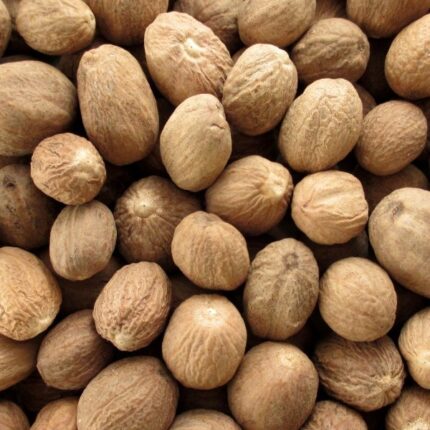Asafoetida (Ferula asafoetida) is the dried sap or gum resin obtained from the roots of Ferula plants. It’s commonly dried, ground into a coarse, yellow powder, and used for either culinary or medicinal purposes. Asafoetida is commonly used in Indian cuisine, where it’s referred to as “HING”. In Ayurvedic medicine, hing is used to aid digestion and gas, as well as treat bronchitis and kidney stones.
Asafoetida
Asafoetida (Ferula asafoetida) is the dried sap or gum resin obtained from the roots of Ferula plants. It’s commonly dried, ground into a coarse, yellow powder, and used for either culinary or medicinal purposes. Asafoetida is commonly used in Indian cuisine, where it’s referred to as “HING”. In Ayurvedic medicine, hing is used to aid digestion and gas, as well as treat bronchitis and kidney stones.
Category: Spices
Related products
Cumin Seed
Cumin is a spice made from the seeds of the Cuminum cyminum plant. Cumin lends its distinctive flavor to chili, tamales and various Indian curries. Its flavor has been described as earthy, nutty, spicy and warm. What’s more, cumin has long been used in traditional medicine. some of the health benefits cumin is traditionally known for, including promoting digestion, reducing food-borne infections, promoting weight loss and improving blood sugar control and cholesterol.
Coriander seed
Coriander, popularly known as dhania in India, is extensively used across various regional cuisines to flavour curries, stir fries, snacks etc. Coriander is one of the oldest of herbs and spices. The fruit of the coriander plant contains two seeds which, when dried, are the portions used as the dried spice. when ripe, the seeds are yellowish-brown or tan in colour with longitudinal ridges. Coriander seeds are available throughout the year, in whole or in ground powder form.In Ayurveda, it is often recommended for stomach related ailments, as it is known to ease digestion.
Nutmeg
Nutmeg (Myristica fragrans Houtt.) is a spice seed that belongs to the family Myristicaceae. Nutmeg is the shelled, dried seed of the plant Myristica fragrans, and mace is the dried net-like covering of the shell of the seed. Nutmeg and its close relative, mace, have been used extensively in folk medicine for a wide range of ailments, including digestive disorders, rheumatism, cholera, and flatulence.
Black mustard
Mustard seeds are the small round seeds of various mustard plants. The seeds are usually about 1 to 2 millimetres (0.039 to 0.079 in) in diameter and may be colored from yellowish white to black. Mustard is a multi-faceted botanical with several different varieties. Three variants out of these varieties – namely white mustard (Brassica alba,) black mustard (Brassica nigra), and brown mustard (Brassica juncea), have gained more popularity over others, and are commercially grown and used for their young flower stalks, leaves, and seeds. The seed and oil from the seed are used to make medicine.Black mustard oil is used for the common cold, painful joints and muscles (rheumatism), and arthritis. Black mustard seed is used for causing vomiting, relieving water retention (edema) by increasing urine production, and increasing appetite.
Basil seeds
Basil seeds aren’t just for growing basil plants — you can also eat them.They look similar to sesame seeds but are black. The type that you eat typically comes from sweet basil, Ocimum basilicum, which is the plant commonly used to season foods. For this reason, the seeds are typically referred to as sweet basil seeds. They also go by many other names, including sabja and tukmaria seeds.helping with weight management, and helping prevent diseases such as cardiovascular disease and certain cancers. Although promising, current research is scarce and in its early stages.
Cinnamon
Cinnamon is a spice that comes from the branches of trees of the Cinnamomum family. As a spice, cinnamon is available in powder form or whole, as pieces of bark. People can also use cinnamon essential oil and supplements. The compounds in cinnamon have antioxidant, anti-inflammatory, antidiabetic, and antimicrobial properties, and that they might offer protection from cancer and cardiovascular disease, among other conditions
Green Cardamom
Green cardamom is a aromatic spice with a very wide range of uses. The plant has underground stems with leafy roots, large white or pale green leaves, pale green fruits and black seeds. The spice has a very warm aroma and pungent taste which it can retain for a very long time. Helps in reducing gas, countering acidity and is considered good for asthma patients. It can also increase appetite and be used as a mouth freshener
Dry ginger
It’s among the healthiest (and most delicious) spices on the planet. It belongs to the Zingiberaceae family, and it’s closely related to turmeric, cardamom, and galangal. The rhizome (underground part of the stem) is the part commonly used as a spice. It’s often called ginger root or, simply, ginger. Ginger can be used fresh, dried, powdered, or as an oil or juice. It’s a very common ingredient in recipes. It’s sometimes added to processed foods and cosmetics. "SAUNTH" is dry ginger powder that is usually consumed in form of kadha or churan.











Reviews
There are no reviews yet.